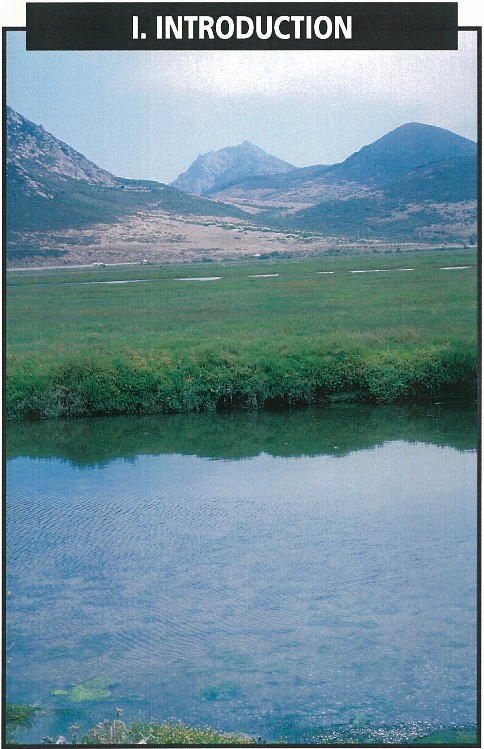WETLANDS OF THE CENTRAL AND SOUTHERN CALIFORNIA COAST
A Methodology for Their Classification and Description
FOREWORD
This report focuses more on the proposed methodology for classifying California wetlands than on providing a complete catalogue of their types or inventory of examples. The catalogue of types is not exhaustive, but expands on the initial catalogue of the draft report. We encourage review and comment on the methodology, with the ultimate collective goal of providing a useable identification and assessment tool in an effort to help document and conserve the natural riches of the study region, and perhaps beyond.
Although funded in large part by the U.S. Environmental Protection Agency, this document and its contents resulting from our study do not represent the views, methods, or conclusions of this agency. The issue of limits of federal regulatory jurisdiction of Waters of the U.S., including wetlands under the federal Clean Water Act, in central and southern California is not specifically addressed in detail herein, as discussion and review of this topic was not the intent nor motivation of the authors. This document also does not necessarily represent the views of the institutions with which the authors are associated. It is the goal of the authors, however, to publish this document so that it will be available to a broader audience. Any individual or organization who wishes to assist with this publication endeavor is encouraged to contact the authors.
We have been rewarded throughout our work with exposure to a portion of the wealth of the State's wetlands heritage and to the magnitude of their beauty. Without agency concern and appreciation for presentation of this heritage, preparation of the report using color photographs would not have been possible, and would not have had the same impact. This document also serves as Environmental Report No. 1 of the Museum of Systematics and Ecology, Department of Biological Sciences, University of Santa Barbara.
Wayne R. Ferren Jr., UCSB
Peggy L. Fiedler, SFSU
Robert A. Leidy, EPA, UCD
February 6, 1995
Introduction
Classification of California Wetlands
Early Efforts
Improvements and Additions
Agency Efforts
A Modified Cowardin et al. Approach
Rationale for the Classification
How to Use this Classification Methodology
The Classification Tables
Systems, Subsystems, Classes, and Subclasses of Wetlands
Water Regimes: Wetlands and Deep Water Habitats
Water/Soil Chemistry: Wetlands, and Deep Water Habitats
Hydrogeomorphic Units: Marine and Estuarine Systems
Hydrogeomorphic Units: Riverine, Lacustrine, and Palustrine System
Substrate/Dominance/Characteristic Types: Marine and Estuarine Systems
Substrate/Dominance/Characteristic Types: Riverine, Lacustrine, and Palustrine Systems
Introduction
Marine Wetlands
Marine Wetland Classes and Subclasses
Marine Hydrogeomorphic Units
Ecosystem Functions and Socio-Economic Values
Socio-Economic Values
Losses and Impacts to Marine Wetlands
Losses
Impacts
Restoration and Creation of Marine Wetlands
Rare or Threatened Wetlands
Classification of Marine Wetlands
Key to the Marine Wetland Classes and Subclasses
Table of Hydrogeomorphic Units in the Marine System Arranged Within Corresponding Water Regimes
Catalogue of Marine Wetlands
Introduction
Estuarine Wetlands
Types of Estuaries
River Mouth Estuaries
Canyon Mouth Estuaries
Lagoonal Estuaries
Coastal Dune-Creek Estuaries
Bay Estuaries
Structureal Basin Estuaries
Artificial Drain Estuaries
Estuarine Wetland Classes and Subclasses
Estuarine Hydrogeomorphic Units
Ecosystem Functions and Socio-Economic Values
Ecosystem Functions
Socio Economic Values
Estuarine Wetlands: Losses and Impacts
Losses
Impacts
Restoration and Creation of Estuarine Wetlands
Rare or Threatened Wetlands
Classification of Marine Wetlands
Key to the Estuarine Wetlands Classes
Table of Estuarine Geogeomorphic Units Arranged Within Corresponding Water Regimes
Catalogue of Estuarine Wetlands
Introduction
Riverine Wetlands
Types of Rivers, Streams, and Washes
Riverine Wetlands Subsystems, Classes, and Subclasses
Riverine Hydrogeomorphic Units
Ecosystem Functions and Socio-Economic Values
Ecosystem Functions
Socio Economic Values
Impacts and Losses
Modification of Natural Flow and Retention Patterns
External ThreatsL Riverine Systems as Open Ecosystems
Riverine Systems as Disturbance Driven Ecosystems
Loss of Resistance and Resilience in Riverine Ecosystems
Restoration and Creation of Riverine Wetlands
Rare or Threatened Wetlands
Key to the Riverine Wetland Subsystems and Classes
Table of Riverine Geogeomorphic Units Arranged Within Corresponding Water Regimes
Catalogue of Riverine Wetlands
Introduction
Lacustrine Wetlands
Types of Estuaries
Natural Lakes
Artificial Reservoirs
Lacustrine Wetland Classes and Subclasses
Lacustrine Hydrogeomorphic Units
Ecosystem Functions and Socio-Economic Values
Ecosystem Functions
Socio Economic Values
Impacts and Losses
Restoration and Creation of Lacustrine Wetlands
Rare and Threatened Lacustrine Wetlands
Key to the Lacustrine Wetland Subsystems and Classes
Table of Hydrogeomorphic Units in the Lacustrine System Arranged Within Corresponding Water Regimes
Catalogue of Lacustrine Wetlands
Introduction
Palustrine Wetlands
Palustrine Wetland Classes and Subclasses
Palustrine Hydrogeomorphic Units
Ecosystem Functions and Socio-Economic Values
Ecosystem Functions
Socio Economic Values
Palustrine Wetland Losses and Impacts
Losses
Impacts
Restoration and Creation of Palustrine Wetlands
Rare and Threatened Palustrine Wetlands
Vernal Pools
Vernal Ponds
Palustrine Vernal Lakes
Vernal Alkali Plains
Dune Swale Wetlands
Coastal Canyon Bottom
Forested Riparian Corridors
Classification of the Palustrine Wetlands
Key to the Palustrine Wetland Classes
Table of Hydrogeomorphic Units in the Palustrine System Arranged Within Corresponding Water Regimes
Catalogue of Palustrine Wetlands
Introduction
Background
The Ventura River Watershed
Physical Characteristics
Estuarine Characteristics
Marine Characteristics
History of Land and Water Development
Methods
Data Collection
Data Analysis
Assessment of Functions and Values
Description of Wetlands Types and Distribution
Marine System
Estuarine System
Lacustrine System
Riverine System
Palustrine System
Watershed Distribution
Assessment of Functions and Values












